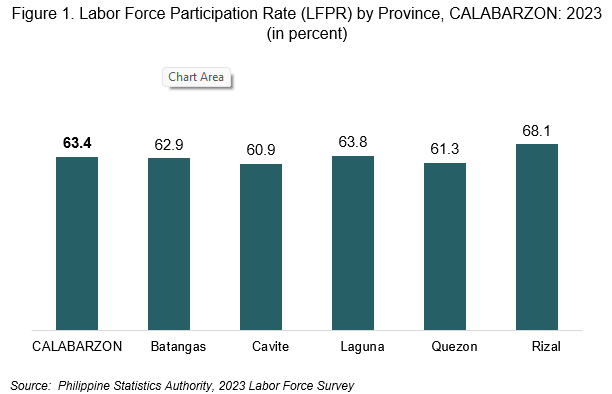
The number of persons in the labor force in CALABARZON reached about 7.5 million of the estimated 11.9 million population 15 years old and over for 2023 (See summary statistics). This translates to a labor force participation rate (LFPR) of 63.4 percent, which means that about 63 out of 100 population aged 15 years and over in the region were either employed or unemployed. It registered a decrease of 1.1 percentage points compared to the LFPR in 2022 which is 64.5 percent.
Moreover, Rizal posted the highest LFPR among the provinces with 68.1 percent. While the province of Cavite recorded the lowest LFPR with 60.9 percent.
Employment rate was highest in Laguna at 95.6 percent
The 2023 employment rate (ER) in Laguna was at 95.6 percent, the highest among the five provinces. It was higher than the region’s employment rate estimated at 94.6 percent. Rizal province recorded the lowest ER at 93.0 percent.
Compared to the annual ER in 2021 and 2022, all the provinces recorded an increase in ER. For the region, the increase was at 4.2 percentage points and 1.0 percentage point from 2021 to 2022 and 2022 to 2023, respectively. About 84 thousand people was added as part of the working population in 2023.
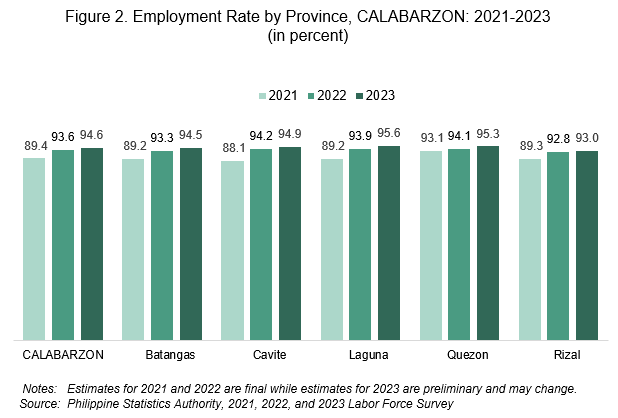
Unemployment rate for 2023 was estimated at 5.4 percent
A lower annual unemployment rate in 2023 was recorded for the region at 5.4 percent, from 6.4 percent in 2022. Unemployment rate was highest in Rizal province at 7.0 percent. It was followed by the province of Batangas and Cavite with 5.5 percent and 5.1 percent, respectively. The total number of unemployed people in CALABARZON was 408 thousand. (see Summary table)
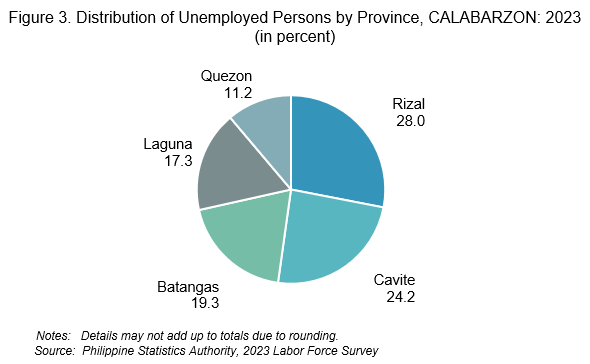
Out of the 408 thousand unemployed persons in the region, more than a quarter (28.0 percent) were located in the province of Rizal. Moreover, about 11 in 100 unemployed persons resided in Quezon province. While the rest of the unemployed (about 248 thousand or 60.8 percent of the total) were located in the different cities and municipalities in the provinces of Batangas, Cavite, and Laguna.
More workers in Batangas considered themselves as underemployed
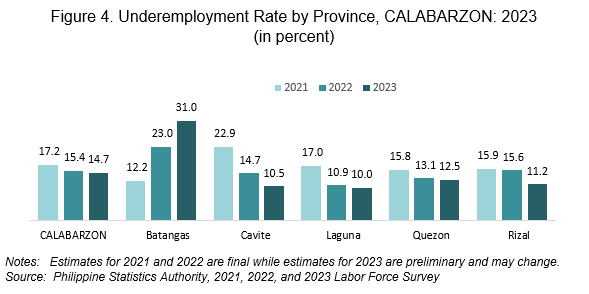
The underemployed persons in the region were estimated at around 1.05 million in 2023, lower than the 1.13 million workers in 2021. This number represented 14.7 percent of the total employed persons in 2023.
On the other hand, the year-on-year decrement in the provinces was highest in the province of Rizal at 4.4 percentage points from 15.6 percent in 2022 to 11.2 percent in 2023. Meanwhile, only the province of Batangas posted an increment by about 8.0 percentage points from 23.0 percent in 2022 to 31.0 percent in 2023. This translates to about 420 thousand working population in the province considering themselves as underemployed.
Note that the underemployed persons are those who were employed but still express their desire to have additional hours of work in their present job or to have an additional job or have a new job with longer working hours.
Summary of Labor Market Statistics: 2021-2023
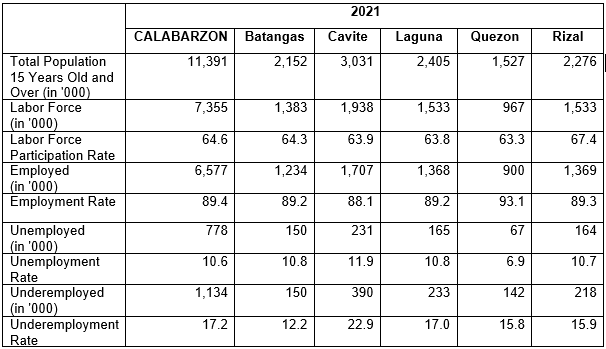
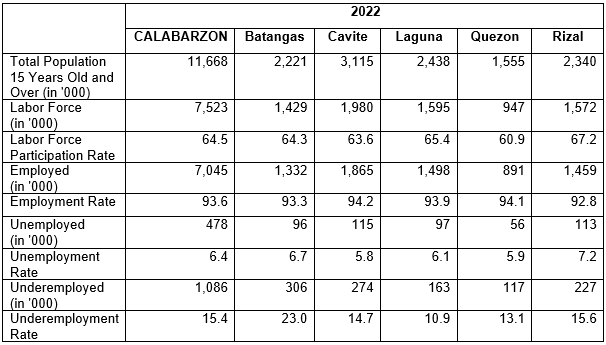
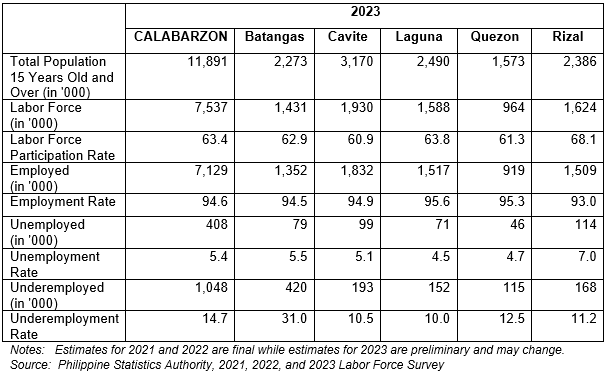
Highlights
• With about 11.9 million estimated population 15 years old and over, labor force participation rate was at 63.4 percent in 2023.
• Total labor force population for the region was estimated at 7.5 million.
• Laguna registered the highest employment rate among the provinces at 95.6 percent; while unemployment rate was highest in Rizal province at 7.0 percent.
• Total unemployed persons reached 408 thousand or an unemployment rate of 5.4 percent.
• Underemployment rate decreased in all provinces except in the Batangas with rate of 31.0 percent.
(SGD.)
CHARITO C. ARMONIA
Regional Director
COB/JGM
-------------------------------------------------------------------------------------------
TECHNICAL NOTES
ANNUAL LABOR FORCE SURVEY
I. Introduction
a. Background
The Annual Labor Force Survey (LFS) refers to the average of data collected across all survey rounds throughout the year. It produces labor and employment statistics for the full year, providing a more comprehensive analysis of the Philippine labor market, including the regional, provincial, and highly urbanized city (HUC) levels.
The LFS is a nationwide survey of households conducted by the Philippine Statistics Authority (PSA) to gather data on the demographic and socio-economic characteristics of the population. The LFS aims to provide a quantitative framework for the preparation of plans, and formulation of policies affecting the labor market.
Originally, the LFS was being conducted on a quarterly basis, specifically in January, April, July, and October. Starting 2021, special rounds of LFS, known as monthly LFS were conducted in response to the need for high-frequency data to monitor the impacts of the Coronavirus Disease of 2019 (COVID-19) pandemic on the Philippine labor market.
With the addition of the monthly surveys in 2021, the increased frequency of data collection introduced new challenges in estimating the annual labor statistics. Therefore, the PSA adopted an official estimation methodology for annual LFS through PSA Board Resolution No. 14, Series of 2021, enabling the generation of labor and employment statistics at the national, regional, provincial and HUC levels.
b. Objectives
The LFS gathers information on the levels and trends on labor force, employment, unemployment, and other relevant indicators for monitoring and planning purposes related to the labor market.
c. Scope and Coverage
Persons aged 15 years old and over who reside in private households in the country are covered in this survey as part of the working population. However, persons who reside in the institutions are not within the scope of the survey.
In addition, Overseas Filipino Workers are not considered part of the labor force in the Philippines. Hence, in the LFS, data on the economic characteristics of household members who are overseas workers are not collected. In the LFS report, they are excluded in the estimation of the size of the working population and in the estimation of the labor force.
d. Developments in the LFS
The LFS, as in any survey, adopts recent developments in statistical methodology/processes and in the education system. The revisions in the LFS are as follows: (1) the population projections based on the 2015 Population Census (POPCEN 2015) has been adopted to generate the labor force statistics; (2) starting 2012 LFS, the codes for industry adopted the 2009 Philippine Standard Industrial Classification (PSIC); (3) the 2012 Philippine Standard Occupational Classification (PSOC) was adopted starting 2016; (4) in January 2019, the 2017 Philippine Standard Classification of Education (PSCED) has been adopted; (5) in January 2017 round of the LFS, the Computer-Assisted Personal Interviewing (CAPI) system using a tablet was utilized in the enumeration; (6) starting 2020, a hybrid approach was used in data collection, a mixed mode of CAPI, face-to-face interview, whenever possible, or a telephone interview; (7) additional questions on vocational course, Enhanced Community Quarantine (ECQ/Lockdown/COVID-19 pandemic was included in the reasons for working more than 48 hours, less than 40 hours, and not looking for work and questions on the work arrangement, days worked in the past week and temporary unemployment.
II. Concepts and Definitions
a. Reference Period
The reference period for this survey is the “past week” referring to the past seven days preceding the date of visit of the enumerator or the interviewer.
b. Employment Status Concepts
1. Population 15 Years Old and Over
This refers to the number of population 15 years old and over excluding overseas workers. Overseas workers are excluded in the estimation of the size of working population (population aged 15 years and over) since the data on their economic characteristics are not collected because they are not considered part of the labor force in the country.
2. In the Labor Force or Economically Active Population
This refers to 15 years old and over who are either employed or unemployed in accordance with the definitions described below.
3. Employed
This refers to persons 15 years old and over who during the reference period are reported either:
a. At work, i.e., those who do any work even for one hour during the reference period for pay or profit, or work without pay on the farm or business enterprise operated by a member of the same household related by blood, marriage, or adoption; or
b. With a job but not at work, i.e., those who have a job or business but are not at work because of temporary illness or injury, vacation, or other reasons. Likewise, persons who expect to report or to start operation of a farm or business enterprise within two weeks from the date of the enumerator’s visit are considered employed.
4. Underemployed
This refers to employed persons who express the desire to have additional hours of work in their present job, or an additional job, or a new job with longer working hours. Visibly underemployed persons are those who work for less than 40 hours during the reference period and want additional hours of work.
5. Unemployed
Starting April 2005, the new unemployment definition was adopted per NSCB Resolution Number 15 dated October 20, 2004. As indicated in the said resolution:
Unemployed persons include all those who, during the reference period, are 15 years old and over as of their last birthday, and reported as persons:
a) Without work, i.e., had no job or business during the reference period; and
b) Currently available for work, i.e., were available and willing to take up work in paid employment or self-employment during the reference period, and/or would be available and willing to take up work in paid employment or self-employment within two weeks after the interview date; and
c) Seeking work, i.e., had taken specific steps to look for a job or establish a business during the reference period; or
d) Not seeking work due to the following reasons: (1) tired or believe no work available, i.e., discouraged workers; (2) awaiting results of previous job application; (3) temporary illness or disability; (4) bad weather; and/or (5) waiting for rehire or job recall.
6. Persons Not in the Labor Force
This refers to persons 15 years old and over who are neither employed nor unemployed according to the definitions mentioned. Those not in the labor force are persons who are not looking for work because of reasons such as housekeeping, schooling and permanent disability. Examples are housewives, students, persons with disability, or retired persons.
